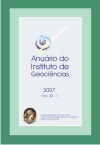Relationship Between Multivariate Enso Index (MEI) and SST of Niños regions with the precipitation in the homogeneous regions on Rio Grande do Sul State
DOI:
https://doi.org/10.11137/2007_2_11-22Abstract
On Rio Grande do Sul the seasons of the year are well defined being felt, in its peculiar characteristics, in the winter, in the spring, in the summer and in the autumn. The pluviometric regime is quite regular and the precipitations are well distributed during all the year on the State. The Multivariate Enso Index (MEI) lacks of a study about its relations with the precipitation. It is a numeric index that integrates the action of different factors that characterize the phenomenon and that oscilate between positive values for the warm phase, the El Niño, and negative values for the cold phase, the La Niña. It considers, in its composition, the following variables: sea level pressure, zonal and meridional wind components at the surface, the Sea Surface Temperature (SST), the air temperature at the surface and a cloudiness indicator. This work had the objective to study the relations between the MEI and the SST of the Niño regions with the precipitations on Rio Grande do Sul State. For this, it were utilized total monthly data of precipitation from 40 meteorological stations of Rio Grande do Sul, bimonthly data of MEI and SST of the Niño regions for the period 1950 to 2002. The correlation coefficients between the precipitation of the Rio Grande Do Sul with the MEI and the regions of the Niños showed low values due to the fact of if using only the months of the beginning and end of the event. The MEI, although to be a more complex index of the methodologic point of view, it does not improve the coefficients of correlation with the precipitation of the State of the Rio Grande do Sul, and it always presents lesser or equal values to obtained when using the TSM of the regions of the Niños in the out/nov and nov/dez coupled of months. The MEI and the Niños regions 3 and 3.4 present the highest correlation coefficient with the Rio Grande do Sul State precipitation for the bimonths oct/nov and nov/dec.Downloads
Download data is not yet available.
Downloads
Published
2007-12-01
How to Cite
Lopes, F. Z., Diniz, G. B. and Marques, J. R. (2007) “Relationship Between Multivariate Enso Index (MEI) and SST of Niños regions with the precipitation in the homogeneous regions on Rio Grande do Sul State”, Anuário do Instituto de Geociências. Rio de Janeiro, BR, 30(2), pp. 11–22. doi: 10.11137/2007_2_11-22.
Issue
Section
não definida
License
This journal is licensed under a Creative Commons — Attribution 4.0 International — CC BY 4.0, which permits use, distribution and reproduction in any medium, provided the original work is properly cited.















